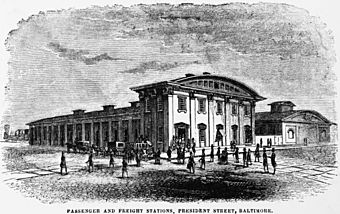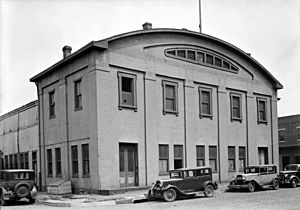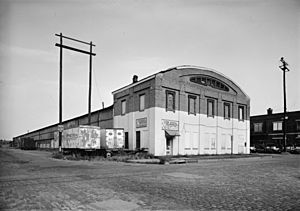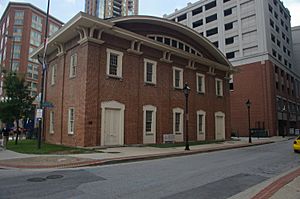President Street Station facts for kids
|
President Street Station
|
|

An 1856 illustration of President Street Station in Baltimore
|
|
| Location | President Street at Fleet Street (southeast corner) Baltimore, Maryland, U.S. |
|---|---|
| Area | less than one acre |
| Built | 1849 |
| Architect | Parker, George A.; Isaac Ridgeway Trimble; Philadelphia, Wilmington and Baltimore Railroad |
| Architectural style | Mid 19th Century Revival, Italianate, Greek Revival |
| Restored | 1996-1997 |
| NRHP reference No. | 92001229 |
Quick facts for kids Significant dates |
|
| Added to NRHP | September 10, 1992 |
The President Street Station in Baltimore, Maryland, is a very old train station. It was built in 1849 and opened in 1850. This station is special because it saw some of the first fighting of the American Civil War (1861-1865). It was a key railway spot during that war. Today, it's the oldest big-city train station still standing in the United States.
In 1997, the station was saved and fixed up. Now, it's a museum called the Baltimore Civil War Museum.
Contents
History of President Street Station
Early Railroad Days in Baltimore
The Baltimore and Port Deposit Rail Road (B&PD) started in 1832. By 1837, it had a train line from Baltimore to the Susquehanna River. The end of this line in Baltimore was near the Inner Harbor.
The B&PD shared tracks with the Baltimore and Ohio Railroad (B&O). The B&O was the country's oldest railroad, started in 1827. Passengers would switch from one train to another. Horse-drawn cars moved people between stations. This was because steam engines were not allowed on city tracks. People worried they would scare horses or cause fires.
By 1838, the Philadelphia, Wilmington and Baltimore Railroad (PW&B) carried passengers from Philadelphia to Baltimore. From Baltimore, travelers could go west with the B&O. They could also go south to Washington, D.C..
Building the Station
The PW&B decided to build its own station. It was located at President Street and Canton Avenue. This new station included train yards, a roundhouse, and warehouses. The station, built in the Greek Revival style, opened on February 18, 1850.
The original station had a brick main building with a unique arched roof. It also had a long train shed over the tracks. In 1852, a similar freight building was added next to the passenger station.
President Lincoln and the Civil War
On February 23, 1861, Abraham Lincoln was traveling to become president. He secretly changed trains at President Street Station. This was to avoid a plot to harm him in Baltimore.
The station was also part of the Baltimore riot of 1861. On April 19, 1861, soldiers from Massachusetts were passing through Baltimore. They were on their way to Washington, D.C.. A crowd of people who supported the Southern states attacked them. Several people died, and many were hurt in the fight. This event was one of the first violent clashes of the American Civil War.
Later, in 1873, the Union Railroad built new tracks. These tracks connected the PW&B line to other railroads. This made it easier for trains to travel north to Pennsylvania. A new station, now called Pennsylvania Station, eventually took over most passenger service.
20th Century Changes

The President Street Station continued to be used for freight trains. It also served some passenger trains until 1911. In 1913, the original train shed was damaged by heavy snow. The Pennsylvania Railroad, which owned the station, replaced it with a new, shorter shed.
Later, the station became a warehouse. By 1970, the train shed was destroyed by fire. Only the main building remained. In 1979, the city of Baltimore took over the empty building. There were plans to tear it down for a new highway. However, the highway was never built.
In 1989, the station's wooden arched roof collapsed during a snowstorm.
Baltimore Civil War Museum
In the 1990s, people worked together to save the station. A group called the Friends of the President Street Station helped. They raised money to rebuild and fix up the historic site. The building reopened in April 1997. It became the "Baltimore Civil War Museum." The Baltimore and Ohio Railroad Museum also helped.
The museum was run by different groups over the years. It closed temporarily in 2007 due to money issues. Later, it reopened on weekends with volunteers. In 2010, it was open for Black History Month.
In 2009, Baltimore City wanted to make the station a landmark. This would protect its outside appearance. The city also looked for businesses to use the area. The Friends of the President Street Station wanted it to stay a museum. They hoped the National Park Service (NPS) would manage it. City officials said any business use must respect the station's history.
As of 2015, the Friends of the Pennsylvania Street Station operate the museum.
National Park Service Study
In 2015, U.S. Senators Barbara Mikulski and Benjamin Cardin suggested a study. They wanted the National Park Service to see if the station could become part of the National Park System. This idea became law in 2019.
The NPS started its study of President Street Station in 2019. In 2022, they held public meetings and asked for comments. The study was expected to be finished in 2023.





